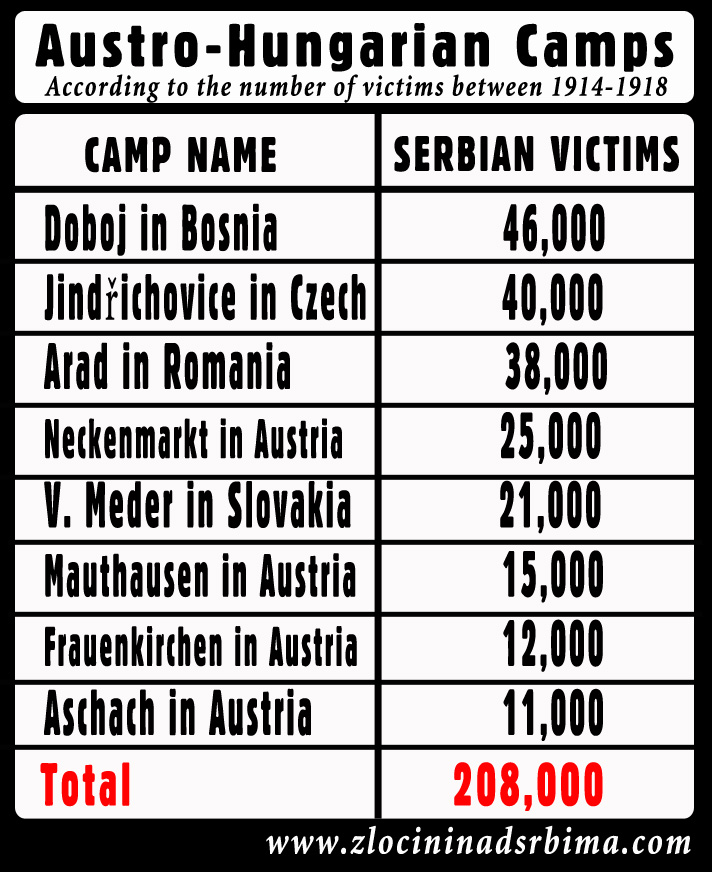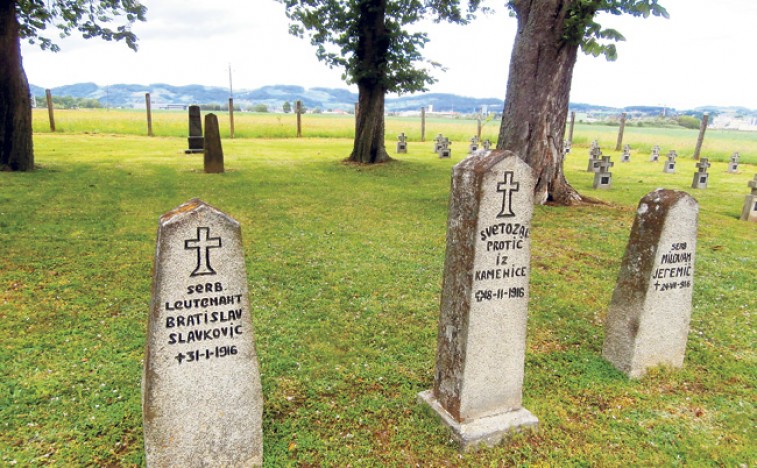|
|
Period:
First World War
Region:
Austro-Hungary
Austro-Hungarian camp in Mauthausen
 The Mauthausen camp was an Austro-Hungarian concentration camp, not far from the town of Linz (20 km), where over 80,000 people, most of them Serbs, Russians, Italians and other nations, were imprisoned during the First World War (WW1). This camp was the first to be formed by order of the Vienna Court in the summer of 1914, that is, right after the monarchy of the Habsburgs declared war on the Kingdom of Serbia. The Mauthausen camp was an Austro-Hungarian concentration camp, not far from the town of Linz (20 km), where over 80,000 people, most of them Serbs, Russians, Italians and other nations, were imprisoned during the First World War (WW1). This camp was the first to be formed by order of the Vienna Court in the summer of 1914, that is, right after the monarchy of the Habsburgs declared war on the Kingdom of Serbia.
This campsite had several branches, among them: Guzen, Ebenze, Wales, Ashach and others.
During the four war years, from 1914 to 1918, over 7,000 Serbs were killed in this camp by Austro-Hungarian authorities. After the Great War, the Austrians called Mauthausen a "factory of death" because, in terms of casualties and atrocities, Mauthausen significantly deviated from other concentration camps.
The conditions in this camp were harsh, and few who managed to survive and afterwards told what was happening there. They were said to have survived the real hell on earth.
The Mauthausen camp was closed in December 1918, after the end of the Great War and the dissolution of the Austro-Hungarian Monarchy. But it was reopened by the Nazis during World War II.
|
FIRST WORLD WAR 1914-1918 |
|
Battles of: Cer, Drina, Kolubara, Leget, Cemerno, Mojkovac, Kajmakcalan, Gornicevo, Dobro Polje
Camps: Mauthausen, Arad, Jindrihovice, Broumov, Boldogasonj, Nadjimer, Nezider, Aschah, Doboj, Sliven
Crimes: Macva, Surdulica, Great Retreat, Sabac
|
Background
At the beginning of 1904, the Kingdom of Serbia signed a trade agreement with the USA, France and Russia... and began exporting its products to the overseas countries through the port of Thessaloniki.
This led to a great economic upswing of the Kingdom of Serbia, which annoyed the Vienna Court, which viewed Serbia as a great rival since Serbia had the highest economic growth rate in Europe at the time, and at the same time a large number of Serbs lived in the occupied territories of the Habsburg Monarchy.

Map of south-eastern Europe in November 1913.
The army of the Kingdom of Serbia liberated its enslaved territories (Raska, Kosovo and Metohija and Old Serbia) from the Turks in the First Balkan War, by achieving major victories in the fall of 1912 at the command of Duke Petar Bojovic at Kumanovo, Prilep and Bitola, and as such completely expelled the Ottomans from the Balkans.
And a year later in the summer of 1913 the army of the Kingdom of Serbia protected Vardar Macedonia from the Bulgarians in the Second Balkan War. The Serbian national revolution was thus continued, at the beginning of the 19th century by Karadjordje Petrovic and Milos Obrenovic.
In the summer of 1914, the Austro-Hungarian Monarchy used the Sarajevo assassination, that is, the assassination of Austrian Crown Prince Franz Ferdinand by members of Young Bosnia (Gavrilo Princip, Bogdan Zerajic, etc.) as an excuse to invade the Kingdom of Serbia, thus starting First World War.

Gavrilo Princip and his comrades in Sarajevo
A dispatch was sent from Vienna, which no sovereign state could accept. Thus, in late July 1914, Austria-Hungary declared war on Serbia. Montenegrin King Nikola I Petrovic and Russian Emperor Nikolai II Romanov immediately sent messages saying that they would help the Serbs. Likewise, German Emperor William II made a military alliance with the Vienna Palace.
Establishment of the Camp
Immediately after the Austro-Hungarian Empire declared war on the small Balkan Kingdom of Serbia and the first fighting on our soil: in Machva and Cer, the authorities in Vienna also established the first camp for prisoners of war and internment from Serbia. The choice fell to Mauthausen twenty miles from the industrial center and the large river port Linz on the upper river Danubе. The camp was built 4.0 kilometers from the town center, on a high bank and not far from the quarry.
With a population of about 5,000, on the banks of the great European river Danube, Mauthausen, it seemed to have been an ideal place for rest and enjoyment. For the Serbs in two world wars, it was a torture and annihilation. A real mass grave. In terms of the number of captives executed, the manner of killing and other atrocities, Mauthausen was a real "death factory".
In the first major skirmishes of the Austrian and Serbian armies on the river Drina, around Sabac, on Gucevo in August 1914, the first casualties also fell. There were prisoners on both sides. The first Serbian prisoners of war were escorted to the Zemun railway station and packed in cargo vans. The Czech guards heard about Mauthausen for the first time. And to be taken there to a prison camp. "It doesn't sound good, but now it's certain they won't shoot us," rejoiced those who had waited for a long journey into uncertainty.
According to archive records, at Mauthausen, on 22 September 1914, some 700 prisoners brought from Vienna began to build a large concentration camp on the bank above the river Dunav. Many of them were in prison for crime. They were guarded by "third party callers" too old to fight on Cer, Drina and other battlefields in Serbia. A month later, the first group of prisoners, some 300 Russian soldiers, were brought here. On 26 October 1914, 1,200 Serbian prisoners of war also arrived.

Conditions in the Camp
One of the first testimonies of the Mauthausen camp was given by an Austro-Hungarian police inspector, who noted that some 8,000 people had died in it, and probably 66% of them were buried alive! The prisoners of that first year of the First World War were without any protection. Instead of barracks, only scantily-placed doorless shelters were erected. Prisoners from the Kingdom of Serbia and other countries slept on the ground. The meals were irregular, and they mostly got salted fish to eat, thus thirst quenching. Winter, disease, famine and "educational measures" or the beating of guards caused the mass death of detainees.
 
The number of captured Serbs has been increasing rapidly, according to prison authorities, by the end of November, there were already 6,000. They were starving, barefoot and naked - zealously recorded by the camp guards. A typhus epidemic was raging in the camp.
By 1917, about 30% of the Serbian population had died in Austro-Hungarian camps, while the rest spent their days in endless anguish and unspeakable suffering, awaiting the inevitable death. In some camps, 200 people died daily.
The brutality with which the Austro-Hungarian authorities treated the detainees caused a stir in European public opinion that neutral countries and international organizations had launched an initiative to protect the prisoners. According to Dr. Archibald Rice, a Swiss professor in Lausanne and a criminologist by profession, the life of Serbian prisoners in the camps was like hell. Recognizing the martyrdom of Serb prisoners in Austro-Hungarian camps, Archibald Rice, referring to the Hague Convention, called for urgent international intervention by neutral countries in order to protect as much as possible the detained Serbs.
Testimonies
Stana Mihajlovic, a doctor from Belgrade, preserved in her diary a poignant picture of the return of our exiles from the camp in the defeated black and yellow monarchy. She stated:
"Our prisoners of war and internment from enemy camps have begun to arrive. They come completely starved, sick and exhausted from the heavy walking. The Great and Little War Island at the mouth of the Sava into the Danube from Kalemgdan provide a creepy sight. These are living skeletons only skin and bones were left behind. Those at the makeshift hospital at Dorcol flooded the rooms, corridors and courtyard.
Returning to the country, many inmates were not welcomed to live in freedom. There was no place for the dead at the morgue. For days, the coaches were transporting dead to the New Cemetery... ".
The Cemeteries
The two military cemeteries in Ashah, where 5,362 Serb prisoners were buried, and on the eastern side of Mauthausen, where a total of about 8,000 Serbs were detained, are testimonies to the suffering of our soldiers far from their birthplace. Few of them survived in this concentration camp. Even at the beginning of its existence, the camp at Mauthausen was said to be real hell.
According to the Linz military authorities, 1,750 Italians, 7,038 Serbs and hundreds of other camp inmates were buried in the new Mauthausen cemetery.

Closing of the Camp
When the war was finally over in late 1918 and the prison camps closed their gates, the surviving Serb inmates made their way to their homes in Serbia in various ways. They were starving and sick, so the journey for them was time-consuming and exhausting, as winter caught them.
The tens of thousands of our people, who managed to survive all the horrors of the camps in Austria, Hungary and the Czech Republic, among whom Mauthausen was the most frightening, drained away from the Serbian capital.
Unfortunately, within the Kalemgdan walls, they had to wait a long time to reach Belgrade and their country. During the four-year war, the enemy destroyed all the vessels, so that the Belgrade authorities had no means with which to transport the weary people to the coast.
On the verge of their homes, exhausted, almost naked, sleeping under clear skies and waiting for boats, those only means of transport that were left alone. Many in the Great War Island died without waiting to step on their hometown again.
Authorities in free Belgrade have opened a hospital at a primary school in Dorcol to receive inmates. Namely, all prisoners were ordered to undergo medical examinations when crossing the Sava and Dunav coasts. The hardest part was getting rid of [? – vasiju – sorry I don’t know this word – is this LICE?
Years later
After the Great War, a magnificent monument was erected, the work of the Italian sculptor Paolo Bodrini. There are four other memorial stones in the Ashah Cemetery, just next to Mauthausen, and one of them has the number of Serbian victims , the number being 7,038.
In the Second World War at Mauthausen, Nazi Germany reopened a camp for detained Jews, soldiers and anti-fascists from 18 countries of enslaved Europe, the Kingdom of Serbia, France, the United States, and even Australia.
In the two world wars of the 20th century, the Mauthausen camp became a large tomb for nearly 25,000 Serbs and members of other South Slavic peoples. This camp was remembered for the unprecedented atrocities of its Austro-Hungarian and Nazi wardens against the detainees. Women, children and the elderly were killed in a brutal manner. Mauthausen and its branches in Guzen, Ebenze, Wales, Ashach and other nearby places are symbols of the mass liquidation of innocent people.

Mauthausen was not the only camp for the enemies of the black and yellow monarchy. The state, which boasted of being "economic" and democratic, had such camps in World War I and in Nizheder, Nagymeyer, Braunau, Arad (in present-day Romania) and other places. Between 1914 and 1918, some 10% of the Serbian population were deported to these equally infamous Mauthausen offices.
Tags:
|
|
AUSTRO HUNGARIAN MONARCHY
|
|
|
|
|
|
| |
Please, vote for this article:
Visited: 4578 point
Number of votes: 27
|